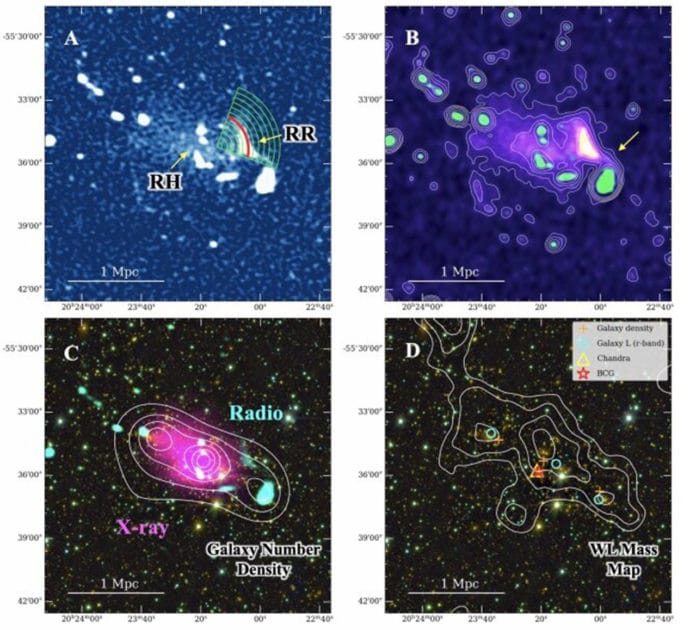An international team of astronomers recently discovered a radio relic in a merging galaxy cluster called SPT-CL 2023-5535. The discovery was made using the Australian Square Kilometer Array Pathfinder (ASKAP).
SPT-CL 2023-5535 (CL2023 for short) is a massive merging galaxy cluster at a redshift of 0.23, with a size of some 727,000 light-years. Various studies have had suggested the presence of diffuse radio emission in the cluster, but due to insufficient spatial resolution of these observations and the existence of several bright neighboring radio point sources, those hypotheses remained disproved.
Now, a group of astronomers led by Kim Hyeong Han of Yonsei University in Seoul, Republic of Korea, reported about the discovery of a radio relic in CL2023 as a result of an analysis of the ASKAP-Evolutionary Map of the Universe (EMU) in-depth, high-resolution radio continuum survey. They used the data from the 4-meter Blanco telescope at the Cerro Tololo Inter-American Observatory and from NASA’s Chandra X-ray spacecraft.
This radio relic extends about 1.6 million light-years in the north-south orientation from the cluster. Its source found to be located at the western edge of a radio halo, coinciding with the intracluster gas, elongated in the east-west direction from CL2023. The radio halo has a size of around 1.6 by 3.2 million light-years.
When it comes to density, the radio flux density of the relic is 16.2 mJy, while its extrapolated radio flux density at 1.4 GHz was measured to be approximately 12.0 mJy. The integrated spectral index of the relic was found to be at a level of -0.76.
Through this discovery, astronomers also calculated the mass of CL2023. CL2023 is indeed an extensive system with a total mass of some 1,040 trillion solar masses. Also, it has at least three subclusters.
In the end, astronomers concluded that CL2023 is a post-merger system, where its two subclusters might have suffered a significant collision between 200 and 300 million years ago.
Journal Reference:
- Discovery of a Radio Relic in the Massive Merging Cluster SPT-CL 2023-5535 from the ASKAP-EMU PILOT SURVEY, arXiv:2007.08244 [astro-ph.HE] arxiv: 2007.08244
